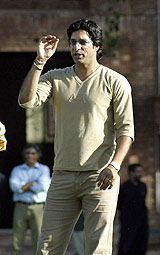
|

Simon Jones's reverse-swinging methods have left the Australians struggling in the current series
© Getty Images
|
|
If only Channel 4, with its wondrous assortment of armchair techno-analysing and
lowbrow jargon busting was broadcasting cricket in 1992:
"So you see Richie, on the left screen, the little dark gentleman is busy
introducing the ball to a bottle top and on the right we see that very ball swinging
very late at high speed straight into the base of leg stump. This is swing but
unconventional, swing but reverse to what you would expect. And that is what the
Pakistanis and Wasim Akram and Waqar Younis in particular, have been doing right
throughout this series."
See, that was the last time a battered old ball swinging when it shouldn't, created
such fuss. Then, it was a fantastical, other-worldly creation of a malevolent,
wild-eyed, wild-haired, moustachioed medium-pacer from the subcontinent. Moreover,
it was an invention cloaked in a maelstrom of fingernails, bottle tops and knives.
Now, the inventor is a wily, ingenious even, resistor of conditions: "Yes, yes,
Sarfraz Nawaz discovered the art. He was a clever one, he was, a little askew but
intelligent." And the bottle tops?
Thirteen summers on, reverse swing has become, apparently and belatedly, legit.
Articles are telling us that the skill stands on the brink of becoming the soul of
this Ashes series. In 1992, despite being the mind, body and soul of Pakistan's 2-1
series win, it was the tarnishing of a series.
And don't you know, there is now a science to it too? One article on a website in
Australia reveals to us the secrets of reverse swing and there's not a single
freakishly long nail, knife or jar of Vaseline in sight. What is it? Who invented
it? For what purpose? Why is it so deadly? What is its impact on the game? The
trick, it is said, is to keep one side of the ball completely dry and even scuffed
and the other as polished as possible and wet. Vitally, the whole team must work
very hard on getting the ball into that condition. This is reverse swing for
dummies, taught as Newtonian laws of motion might be in Physics refresher courses;
rationalized and legitimized.
And if you're still not sure, then of course, you can always call up the true father
of English reverse swing, Mickey Stewart. He, after all knew, back in 1992 as
manager of England for the last time, exactly what reverse swing was and how it was
done. Except he would never tell anyone then and the Pakistani version of working
really hard on the ball as a team and getting one side dry and rough and the other
wet and polished just didn't cut any ice.

|

Wasim Akram and Waqar Younis produced lethal displays of reverse swing on Pakistan's 1992 tour of England
© Getty Images
|
|
Now, opponents must plan assiduously to combat it, and
planning doesn't come any
more assiduous than with the Australians. Use lower back lifts, Mark Taylor tells
us, for that was what Allan Border did to nullify Wasim and Waqar, although Justin
Langer thinks it is detrimental to fluency, and he should know. Others move
extravagantly outside off-stump to open up the leg-side as well as reduce the
likelihood of a leg-before. And if all else fails, then just accuse them of picking
the seam. No wait.
Shed of its oriental mystique and illicit implications, reverse swing, appropriately
perhaps, has risen to grace rather than fallen from it. Dark art to legit science,
villain to hero, vilified to lionised, Flintoff 2000 to Flintoff 2005, Bosie to
googly.
Of course, 1992 and 2005 are not one and the same. There are still differences in
what Wasim and Waqar did and what Flintoff and Jones do. For one, the Pakistani duo
usually had the decency to wait at least 40-50 overs, and sometimes even 65-70,
before they started. Young Jones starts reversing as early as the 15th over, which
says something not only about his ability but also how hard the England team must
work on the ball. (Exactly what it says, however, nobody except Mickey Stewart is
certain.)
And back then, the two Ws conjured only the most frenzied disintegrations from
situations of relative idyll: 197 for 3 finished 255 all out at Lord's; 292 for 2 at
Headingley became 320 all out; 182 for 3 at The Oval swiftly ended 207 all out. In
the current series, the havoc realised by an old ball is a little more prosaic;
Australia "collapsed" from 194 for 3 to 308 at Edgbaston or 119 for 3 to 302 all
out, sustained yes but lacking the sheer statistical madness of 1992. And tellingly,
as Edgbaston and Old Trafford proved, tailenders are not as prone to this reverse
swing as they were once.
Now, in a few months' time, what Gideon Haigh referred to as one of the headline
trends of the 1990s, will complete an astounding rehabilitation. With England arriving
in Pakistan, the spiritual and necessary home of the skill, with two of the best
practitioners now on their side, reverse swing completes as admirable a tale of
redemption as any, an apt closure from a disreputable past. And if it turns out that
Wasim at Lancashire and Waqar at Glamorgan had anything to do with Flintoff and
Jones's mastery of this skill, then well, isn't that just the cutest thing?
Osman Samiuddin is Pakistan editor of Cricinfo



